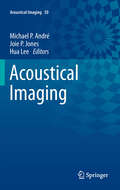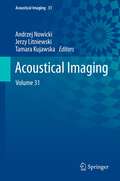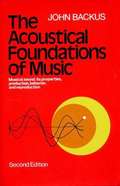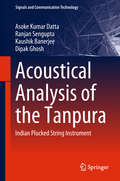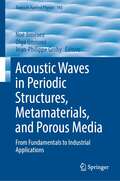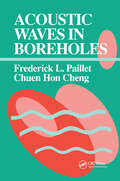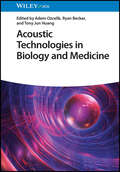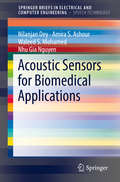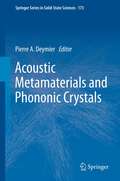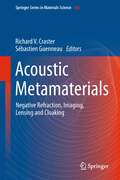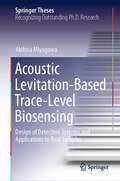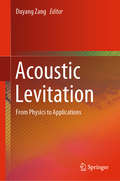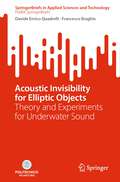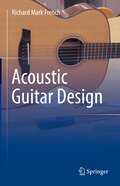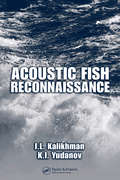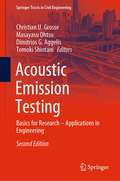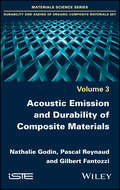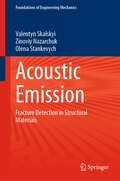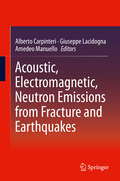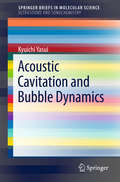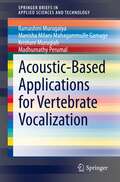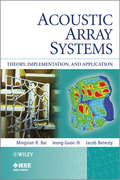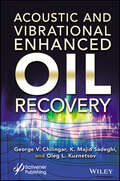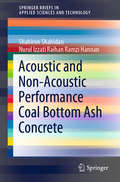- Table View
- List View
Acoustics: An Introduction to Its Physical Principles and Applications (Physical Acoustics Ser. #Volume 19)
by Allan D. PierceThis corrected version of the landmark 1981 textbook introduces the physical principles and theoretical basis of acoustics with deep mathematical rigor, concentrating on concepts and points of view that have proven useful in applications such as noise control, underwater sound, architectural acoustics, audio engineering, nondestructive testing, remote sensing, and medical ultrasonics.Since its publication, this text has been used as part of numerous acoustics-related courses across the world, and continues to be used widely today. During its writing, the book was fine-tuned according to insights gleaned from a broad range of classroom settings. Its careful design supports students in their pursuit of a firm foundation while allowing flexibility in course structure. The book can easily be used in single-term or full-year graduate courses and includes problems and answers. This rigorous and essential text is a must-have for any practicing or aspiring acoustician.
Acoustical Imaging: Volume 30 (Acoustical Imaging #30)
by Hua Lee Joie P. Jones Michael P. AndréIn the course of the years the volumes in the Acoustical Imaging Series have developed to become well-known and appreciated reference works. Offering both a broad perspective on the state of the art in the field as well as an in-depth look at its leading edge research, this Volume 30 in the Series contains again an excellent collection of contributions, presented in five major categories:
Acoustical Imaging: Volume 31 (Acoustical Imaging #31)
by Andrzej Nowicki Jerzy Litniewski Tamara KujawskaThe International Symposium on Acoustical Imaging is a unique forum for advanced research, covering new technologies, developments, methods and theories in all areas of acoustics. This interdisciplinary Symposium has been taking place continuously since 1968. In the course of the years the proceedings volumes in the Acoustical Imaging Series have become a reference for cutting-edge research in the field. In 2011 the 31st International Symposium on Acoustical Imaging was held in Warsaw, Poland, April 10-13. Offering both a broad perspective on the state-of-the-art as well as in-depth research contributions by the specialists in the field, this Volume 31 in the Series contains an excellent collection of papers in six major categories: Biological and Medical Imaging Physics and Mathematics of Acoustical Imaging Acoustic Microscopy Transducers and Arrays Nondestructive Evaluation and Industrial Applications Underwater Imaging
The Acoustical Foundations of Music (2nd edition)
by John BackusThe original purpose of Professor Backus's book was to collect and organize the scattered results of research, past and present, in the areas of scientific knowledge that are relevant to music: the physiological properties of sounds; the effect of acoustical environment; the acoustical behavior of musical instruments; and the various applications of electronics and computers to the production, reproduction, and composition of music. The aims and organization of the second edition remain the same; the results are more complete and up-to-date.
Acoustical Analysis of the Tanpura: Indian Plucked String Instrument (Signals and Communication Technology)
by Asoke Kumar Datta Ranjan Sengupta Kaushik Banerjee Dipak GhoshThis book addresses the acoustic signal analysis and spectral dynamics of the tanpura, an Indian plucked string instrument. In addition, it strives to provide a logical and objective explanation of Indian classical musicians’ cognitive experience. Issues of relevance in this regard include the rich, mellifluous sound; the undulation of the loudness; the somewhat cyclical variation of the timbre, which is strongly related to these undulations; and the occasional perception of virtual notes to which no strings are tuned. The book analyses the materials used in the tanpura, the instrument’s simple structure, the intricacies of the lower bridge, and the theory of string vibration with variable string length. Cognitive experiments to provide the basis for perceptual quality assessment, as well as a methodology for ranking, are described. This is followed by acoustic analyses, both temporal and spectral, for sounds produced by male and female tanpuras, for each individual string and the combined one. An important aspect related to the naturalness of perceived sound, namely the intrinsically associated random perturbations, is also discussed. The apparent irregularities perceived in the acoustic signal produced by the tanpura reveal the importance of examining the signal from the perspective of non-linear analysis, an aspect that is also covered in the book. Given its scope, the book will appeal to students and researchers in the fields of music acoustics, artificial intelligence, and cognitive science, as well as musicians and musicologists around the world.
Acoustic Waves in Periodic Structures, Metamaterials, and Porous Media: From Fundamentals to Industrial Applications (Topics in Applied Physics #143)
by Noé Jiménez Olga Umnova Jean-Philippe GrobyThis book delivers a comprehensive and up-to-date treatment of practical applications of metamaterials, structured media, and conventional porous materials. With increasing levels of urbanization, a growing demand for motorized transport, and inefficient urban planning, environmental noise exposure is rapidly becoming a pressing societal and health concern. Phononic and sonic crystals, acoustic metamaterials, and metasurfaces can revolutionize noise and vibration control and, in many cases, replace traditional porous materials for these applications.In this collection of contributed chapters, a group of international researchers reviews the essentials of acoustic wave propagation in metamaterials and porous absorbers with viscothermal losses, as well as the most recent advances in the design of acoustic metamaterial absorbers. The book features a detailed theoretical introduction describing commonly used modelling techniques such as plane wave expansion, multiple scattering theory, and the transfer matrix method. The following chapters give a detailed consideration of acoustic wave propagation in viscothermal fluids and porous media, and the extension of this theory to non-local models for fluid saturated metamaterials, along with a description of the relevant numerical methods. Finally, the book reviews a range of practical industrial applications, making it especially attractive as a white book targeted at the building, automotive, and aeronautic industries.
Acoustic Waves in Boreholes
by Frederick L. Paillet Chuen Hon ChengIntroducing the first, self-contained reference on acoustic waveform loggingAcoustic measurements in boreholes were first made as a specialized logging technique in geological exploration, but recent advances have greatly expanded the potential applications of this technique. Acoustic Waves in Boreholes provides a thorough review of the theory and interpretation techniques needed to realize these applications, emphasizing the role of guided modes and critically refracted waves in determining the characteristics of recorded waveforms. Topics covered in this comprehensive volume include the seismic properties of rocks; propagation of axisymmetric waves along fluid-filled boreholes in isotropic rocks; and symmetric and nonsymmetric sources in isotropic, transversely isotropic, and porous, permeable formations in open and cased boreholes. Each chapter includes the theory of synthetic microseismogram computation, interpretation and data inversion techniques illustrated using computed seismograms, and case histories using experimental data. Appendices providing the mathematical formulation needed to compute microseismograms, with a single consistent notation used throughout, are also included in appropriate chapters.The wide range of geomechanical properties covered in this book will interest exploration geophysicists, reservoir engineers, civil engineers, geologists, and soil scientists.
Acoustic Technologies in Biology and Medicine
by Adem Ozcelik Ryan Becker Tony Jun HuangAcoustic Technologies in Biology and Medicine Complete, balanced resource encompassing all required technical, theoretical, and applied multidisciplinary knowledge related to acoustics Taking a multidisciplinary approach involving fluid mechanics, physics, chemistry, electronics, and the life sciences to provide a unified and competent overview of the field, Acoustic Technologies in Biology and Medicine covers the fundamental principles of acoustic wave generation and propagation, different acoustic systems and technologies with the interplay of physical forces, theoretical foundations, and the state-of-the-art biomedical applications of acoustics. State-of-the-art applications of acoustics in biology and medicine are presented, including single cell and organism manipulation, acoustic biosensing, cancer cell isolation (liquid biopsy), cell/tissue stimulation and ablation, micro-robot actuation, acoustic imaging, and drug delivery. Contributed to and edited by highly qualified professionals with significant experience in the field, Acoustic Technologies in Biology and Medicine covers sample topics such as: Materials for acoustic wave generation and modulation, ultrasound imaging, and photoacoustic imaging and sensing for biomedical applications Therapeutic ultrasound, application of ultrasound responsive reagents for drug delivery systems, and acoustic levitation and acoustic holograms Application of ultrasonic waves in bioparticle manipulation and separation, acoustic biosensors, and acoustic micro and nanorobots in medicine Different technologies of acoustic systems, including bulk and surface acoustic wave-based platforms, acoustic imaging, acoustic sensors, and acoustic levitators A cornerstone reference bridging the gap between rapidly advancing acoustic technologies with state-of-the-art applications in biology and medicine, Acoustic Technologies in Biology and Medicine is an essential resource on the subject for biophysicists, materials scientists, biotechnologists, bioengineers, sensor developers, electronics engineers, and all professionals in the greater biotechnological industry.
Acoustic Sensors for Biomedical Applications (SpringerBriefs in Speech Technology)
by Nilanjan Dey Amira S. Ashour Waleed S. Mohamed Nhu Gia NguyenIn this book, application-related studies for acoustic biomedical sensors are covered in depth. The book features an array of different biomedical signals, including acoustic biomedical signals as well as the thermal biomedical signals, magnetic biomedical signals, and optical biomedical signals to support healthcare. It employs signal processing approaches, such as filtering, Fourier transform, spectral estimation, and wavelet transform. The book presents applications of acoustic biomedical sensors and bio-signal processing for prediction, detection, and monitoring of some diseases from the phonocardiogram (PCG) signal analysis. Several challenges and future perspectives related to the acoustic sensors applications are highlighted. This book supports the engineers, researchers, designers, and physicians in several interdisciplinary domains that support healthcare.
Acoustic Metamaterials and Phononic Crystals (Springer Series in Solid-State Sciences #173)
by Pierre A. DeymierThis comprehensive book presents all aspects of acoustic metamaterials and phononic crystals. The emphasis is on acoustic wave propagation phenomena at interfaces such as refraction, especially unusual refractive properties and negative refraction. A thorough discussion of the mechanisms leading to such refractive phenomena includes local resonances in metamaterials and scattering in phononic crystals.
Acoustic Metamaterials: Negative Refraction, Imaging, Lensing and Cloaking (Springer Series in Materials Science #166)
by Richard V. Craster Sébastien GuenneauAbout the book: This book is the first comprehensive review on acoustic metamaterials; novel materials which can manipulate sound waves in surprising ways, which include collimation, focusing, cloaking, sonic screening and extraordinary transmission. It covers both experimental and theoretical aspects of acoustic and elastic waves propagating in structured composites, with a focus on effective properties associated with negative refraction, lensing and cloaking. Most related books in the field address electromagnetic metamaterials and focus on numerical methods, and little (or no) experimental section. Each chapter will be authored by an acknowledged expert, amongst the topics covered will be experimental results on non-destructive imaging, cloaking by surface water waves, flexural waves in thin plates. Applications in medical ultrasound imaging and modeling of metamaterials will be emphasized too. The book can serve as a reference for researchers who wish to build a solid foundation of wave propagation in this class of novel materials.
Acoustic Levitation-Based Trace-Level Biosensing: Design of Detection Systems and Applications to Real Samples (Springer Theses)
by Akihisa MiyagawaThis book shows the availability and potential of the coupled acoustic-gravitational (CAG) field for trace-level biosensing. The proposed detection scheme also allows the evaluation of the kinetics and thermodynamics of the reaction occurring on a single microparticle (MP). This method has wide applicability in important fields, involving not only chemistry but also life, environmental, and medical sciences. The author proposes novel trace-level biosensing based on measurements of the levitation coordinate shift of an MP in the CAG field. The levitation coordinate of the MP in the CAG field is determined by its density and compressibility. The levitation coordinate shift is induced by the binding of gold nanoparticles (AuNPs) to the MP through interparticle reactions. Therefore, the quantity of molecules involved in the reaction can be determined from the levitation coordinate shift. The author demonstrates the zmol level detection for biotin, DNA/RNA, and organic molecules. In addition, the kinetics and thermodynamics are evaluated for various reactions occurring between the MP and AuNP, such as the avidin-biotin reaction, direct hybridization, sandwich hybridization, and aptamer-target complexation.This book provides a new concept based on the CAG field, in which the extent of a reaction is converted into the levitation coordinate shift, that is, “length.” The proposed method has many advantages over other methods, e.g., high biocompatibility, high applicability, and short analysis time. In addition, because the apparatus used in this study is inexpensive and easy to miniaturize, this method is useful in important practical fields, such as forensic and environmental science and diagnosis. Thus, this book inspires many researchers to apply the present method to their own fields of interest.
Acoustic Levitation: From Physics to Applications
by Duyang ZangThis book systematically introduces readers to the fundamental physics and a broad range of applications of acoustic levitation, one of the most promising techniques for the container-free handling of small solid particles and liquid droplets. As it does away with the need for solid walls and can easily be incorporated into analysis instruments, acoustic levitation has attracted considerable research interest in many fields, from fluid physics to material science. The book offers a comprehensive overview of acoustic levitation, including the history of acoustic radiation force; the design and development of acoustic levitators; the technology’s applications, ranging from drop dynamics studies to bio/chemical analysis; and the insightful perspectives that the technique provides. It also discusses the latest advances in the field, from experiments to numerical simulations. As such, the book provides readers with a clearer understanding of acoustic levitation, while also stimulating new research areas for scientists and engineers in physics, chemistry, biology, medicine and other related fields.
Acoustic Invisibility for Elliptic Objects: Theory and Experiments for Underwater Sound (SpringerBriefs in Applied Sciences and Technology)
by Davide Enrico Quadrelli Francesco BraghinThe book investigates acoustic cloaking for elliptical targets, starting from the development of a systematic approach to deal with such non-axisymmetrical shapes by adopting transformation acoustics in elliptic coordinates, and concluding with numerical and experimental validation of a microstructured cloak in the underwater environment. The book thus comprises all the steps from theory to practice that led to the first experimental validation of acoustic invisibility for non-cylindrical objects, whose results are presented in the last chapter. Indeed, despite Transformation Theory is now an established tool to design material distributions capable to unlock the design of invisibility devices, it is not trivial to apply it for shapes different than the sphere and the cylinder, which are thus the ones mainly addressed in the literature. This book paves the way for exploration of other shapes, demonstrating the effectiveness of a pentamode cloak in reducing the acoustic visibility of an elliptical target, and discussing design choices that can make the implementation of the required microstructure less cumbersome despite the lack of axial symmetry of the problem, from both the numerical and manufacturing point of views.
Acoustic Guitar Design
by Richard Mark FrenchThis book is for experienced luthiers and guitar designers in the industry, novice builders wishing to improve their designs, and guitar owners interested in knowing more about their instruments. It includes the most important technical information gathered from many sources, including the academic literature and the author’s own work, presented here in a clear, actionable form with a minimum of mathematics. The book begins with a historical survey on how important features of the acoustic guitar evolved over centuries. The review leads up to a chapter focusing on three iconic instruments that represent the most important types of acoustic guitars: classical, steel string flat top and archtop. As the guitar market is so strongly conditioned by familiar, traditional instruments, a successful builder must have a thorough working understanding of the most important designs to underpin their own work. Through this volume, Professor French lays out the entire design process and collects detailed information in one convenient source. Luthiers quite often compile notebooks of measurements, part numbers, specific design features and other details they routinely need. This book organizes much of that information, with tables of dimensions, material properties, and other details in one essential final chapter. The book also features concise side bar contributions by top guitar designers and builders including Tim Shaw, Chief Engineer at Fender Music; Bob Taylor, Co-Founder of Taylor Guitars; and Andy Powers, Master Guitar Designer and Partner.
Acoustic Fish Reconnaissance
by I.L. Kalikhman K. I. YudanovUntil now, there has not been any work that systematically presents the subject of acoustic fish reconnaissance, details all major aspects of applying acoustic equipment in commercial fish reconnaissance, and offers sufficient analysis of the effectiveness of fish-finding techniques. Acoustic Fish Reconnaissance responds to this need by providing t
Acoustic Emission Testing: Basics for Research – Applications in Engineering (Springer Tracts in Civil Engineering)
by Christian U. Grosse Masayasu Ohtsu Dimitrios G. Aggelis Tomoki ShiotaniThis book provides an introduction to Acoustic Emission Testing and its applications to different materials like concrete, steel, ceramics, geotechnical materials, polymers, biological structures and wood. Acoustic Emission Techniques (AET) techniques have been studied in engineering for a long time. The techniques are applied more and more to practical investigations and are more and more standardized in codes. This is because the degradation of structures due to ageing urgently demand for maintenance and rehabilitation of structures in service. It results in the need for the development of advanced and efficient inspection techniques. In mechanical engineering and concerning the monitoring of machines and mechanical components, AE is a widely accepted observing deterioration in the frame of structural health monitoring. The advantages of AE like sensitivity, damage localization potential, non-intrusive nature as well as developments in signal analysis and data transmission allow applications that could not be considered decades ago.As such, AE techniques draw great attention to diagnostic applications and in material testing. This book covers all levels from the description of AE basics for AE beginners (level of a student) to sophisticated AE algorithms and applications to real large-scale structures as well as the observation of the cracking process in laboratory specimen to study fracture processes. This book has proved its worth over the past twelve years. Now in its second edition, it will be a resource that sets the standard and equips readers for the future. All chapters from the 1st edition have been updated and rewritten and eight extra chapters (e.g also regarding AE tomography, AE in plate-like structures and AE for investigations of hardening of fresh concrete) have been added.
Acoustic Emission and Durability of Composite Materials
by Nathalie Godin Pascal Reynaud Gilbert FantozziIn this book, two kinds of analysis based on acoustic emission recorded during mechanical tests are investigated. In the first, individual, analysis, acoustic signature of each damage mechanism is characterized. So with a clustering method, AE signals that have similar shapes or similar features can be group together into a cluster. Afterwards, each cluster can be linked with a main damage. The second analysis is based on a global AE analysis, on the investigation of liberated energy, with a view to identify a critical point. So beyond this characteristic point, the criticality can be modeled with a power-law in order to evaluate time to failure.
Acoustic Emission: Fracture Detection in Structural Materials (Foundations of Engineering Mechanics)
by Valentyn Skalskyi Zinoviy Nazarchuk Olena StankevychThe book presents topical theoretical and experimental studies for developing advanced methods of detecting materials fracture and assessing their structural state using acoustic emission. It introduces new mathematical models characterizing the displacement fields arising from crack-like defects and establishes a new criterion for classifying different types of materials fracture based on specific parameters obtained from wavelet transforms of acoustic emission signals. The book applies this approach to experimental studies in three types of materials—fiber-reinforced composites, dental materials, and hydrogen-embrittled steels.
Acoustic, Electromagnetic, Neutron Emissions from Fracture and Earthquakes
by Alberto Carpinteri Giuseppe Lacidogna Amedeo ManuelloThis book presents the relevant consequences of recently discovered and interdisciplinary phenomena, triggered by local mechanical instabilities. In particular, it looks at emissions from nano-scale mechanical instabilities such as fracture, turbulence, buckling and cavitation, focussing on vibrations at the TeraHertz frequency and Piezonuclear reactions. Future applications for this work could include earthquake precursors, climate change, energy production and cellular biology. A series of fracture experiments on natural rocks demonstrates that the TeraHertz vibrations are able to induce fission reactions on medium weight elements accompanied by neutron emissions. The same phenomenon appears to have occurred in several different situations, particularly in the chemical evolution of the Earth and Solar System, through seismicity (rocky planets) and storms (gaseous planets). As the authors explore, these phenomena can also explain puzzles related to the history of our planet, like the ocean formation or the primordial carbon pollution, as well as scientific mysteries, like the so-called "cold nuclear fusion" or the correct radio-carbon dating of organic materials, such as the Turin Shroud. In biology, Piezonuclear reactions could explain the mechanism that governs the so-called "sodium-potassium pump" and more in general, the metabolic processes. Scientists engaged in seismology, geophysics, geochemistry, climatology, planetology, condensed matter physics and b iology, as well as those involved in theoretical and applied mechanics, will all appreciate the innovative work presented here in a holistic way.
Acoustic Cavitation and Bubble Dynamics (SpringerBriefs in Molecular Science)
by Kyuichi YasuiThis brief explains in detail fundamental concepts in acoustic cavitation and bubble dynamics, and describes derivations of the fundamental equations of bubble dynamics in order to support those readers just beginning research in this field. Further, it provides an in-depth understanding of the physical basis of the phenomena. With regard to sonochemistry, the brief presents the results of numerical simulations of chemical reactions inside a bubble under ultrasound, especially for a single-bubble system and including unsolved problems. Written so as to be accessible both with and without prior knowledge of fundamental fluid dynamics, the brief offers a valuable resource for students and researchers alike, especially those who are unfamiliar with this field. A grasp of fundamental undergraduate mathematics such as partial derivative and fundamental integration is advantageous; however, even without any background in mathematics, readers can skip the e quations and still understand the fundamental physics of the phenomena using the book's wealth of illustrations and figures. As such, it is also suitable as an introduction to the field.
Acoustic-Based Applications for Vertebrate Vocalization (SpringerBriefs in Applied Sciences and Technology)
by Ramashini Murugaiya Manisha Milani Mahagammulle Gamage Krishani Murugiah Madhumathy PerumalAcoustic-Based Applications for Vertebrate Vocalization is designed to help researchers improve their findings and knowledge of vertebrate vocalization by focusing on the integration of acoustic features with new technologies, such as the Internet of Things (IoT), cloud computing, and virtual and cognitive reality. The book addresses the most common challenges in vertebrate vocalization-based research via suitable audio signal processing techniques, data collection, data pre-processing, acoustic feature engineering, extraction, and selection for multidisciplinary applications, i.e. feature classification, vertebrate communication, behavioral analysis, and signal pattern analysis. The book is an important reference for scholars, researchers, industry practitioners, teachers, and students across a number of disciplines, including bioengineering, audio engineering, systems engineering, biotechnology, signal processing, biology, zoology, and animal sciences.
Acoustic Array Systems: Theory, Implementation, and Application (Wiley - IEEE)
by Mingsian R. Bai Jeong-Guon Ih Jacob BenestyPresents a unified framework of far-field and near-field array techniques for noise source identification and sound field visualization, from theory to application. Acoustic Array Systems: Theory, Implementation, and Application provides an overview of microphone array technology with applications in noise source identification and sound field visualization. In the comprehensive treatment of microphone arrays, the topics covered include an introduction to the theory, far-field and near-field array signal processing algorithms, practical implementations, and common applications: vehicles, computing and communications equipment, compressors, fans, and household appliances, and hands-free speech. The author concludes with other emerging techniques and innovative algorithms. Encompasses theoretical background, implementation considerations and application know-how Shows how to tackle broader problems in signal processing, control, and transudcers Covers both farfield and nearfield techniques in a balanced way Introduces innovative algorithms including equivalent source imaging (NESI) and high-resolution nearfield arrays Selected code examples available for download for readers to practice on their own Presentation slides available for instructor use A valuable resource for Postgraduates and researchers in acoustics, noise control engineering, audio engineering, and signal processing.
Acoustic and Vibrational Enhanced Oil Recovery
by George V. Chilingar Kazem Majid Sadeghi Oleg Leonidovich KuznetsovACOUSTIC AND VIBRATIONAL ENHANCED OIL RECOVERY Oil and gas is still a major energy source all over the world, and techniques like these, which are more environmentally friendly and inexpensive than many previous development and production technologies, are important for making fossil fuels more sustainable and less hazardous to the environment. Based on research they did in the 1970s in Russia and the United States, the authors discovered that oil rate production increased noticeably several days after the occurrence of an earthquake when the epicenter of the earthquake was located in the vicinity of the oil producing field. The increase in oil flow remained higher for a considerable period of time, and it led to a decade-long study both in the Russia and the US, which gradually focused on the use of acoustic/vibrational energy for enhanced oil recovery after reservoirs waterflooded. In the 1980s, they noticed in soil remediation studies that sonic energy applied to soil increases the rate of hydrocarbon removal and decreases the percentage of residual hydrocarbons. In the past several decades, the use of various seismic vibration techniques have been used in various countries and have resulted in incremental oil production. This outstanding new volume validates results of vibro-stimulation tests for enhanced oil recovery, using powerful surface-based vibro-seismic sources. It proves that the rate of displacement of oil by water increases and the percentage of nonrecoverable residual oil decreases if vibro-energy is applied to the porous medium containing oil. Audience: Petroleum Engineers, Chemical Engineers, Earthquake and Energy engineers, Environmental Engineers, Geotechnical Engineers, Mining and Geological Engineers, Sustainability Engineers, Physicists, Chemists, Geologists, and other professionals working in this field
Acoustic And Non-Acoustic Performance Coal Bottom Ash Concrete (SpringerBriefs in Applied Sciences and Technology)
by Shahiron Shahidan Nurul Izzati Raihan Ramzi HannanThis book highlights the acoustic performance of concrete made with Coal Bottom Ash (CBA) that has contributed to environmental issues. The usage of CBA in concrete can be recommended as good concrete due to its absorption properties. This book focuses on the principles and techniques employed in acoustic design. The book first elaborates on the perception of noise and properties of noise, followed by physical data, units and measurements. Finally, it takes a look at acoustic analysis which includes acoustic performance effects using different volumes of CBA, density and porosity of concrete.
